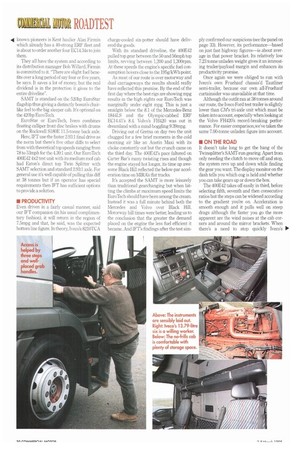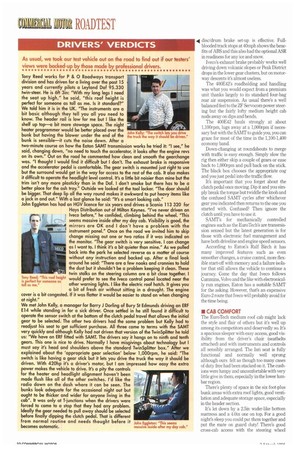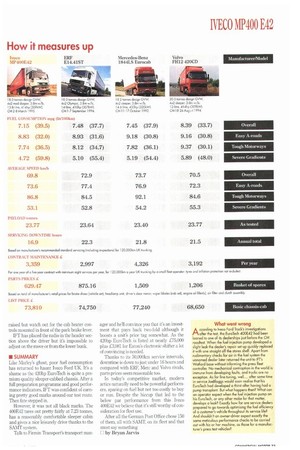ROADTEST
Page 32

Page 34

Page 35

If you've noticed an error in this article please click here to report it so we can fix it.
known pioneers is Kent haulier Alan Firmin which already has a 40-strong ERF fleet and is about to order another four EC14.34s to join them.
They all have the system and according to its distribution manager Bob Willard, Firmin is committed to it. "There are slight fuel benefits over a long period of say four or five years, he says. It saves a lot of money, but the real dividend is in the protection it gives to the entire driveline".
SAMT is standard on the 520hp EuroStar flagship thus giving a distinctly bosun's chairlike feel to the big sleeper cab. It's optional on the 420hp EuroTech.
EuroStar or EuroTech, Iveco combines floating calliper front disc brakes with drums on the Rockwell S180E 11.5-tonne back axle.
Here, IFT use the faster 2.93:1 final drive as the norm but there's five other diffs to select from with theoretical top speeds ranging from 78 to 53mph for the 4,30:1 unit. Our EuroTech 400E42 4x2 test unit with its medium roof cab had Eaton's direct top Twin Splitter with SAMT selection and standard 2.93:1 axle. For general use it's well capable of pulling this diff at 38 tonnes but if an operator has special requirements then IFT has sufficient options to provide a solution, • PRODUCTIVITY Even driven in a fairly casual manner, said our IFT companion (in his usual complimentary fashion), it will return in the region of 7.5mpg and that, he said, was the expected bottom line figure. In theory, Iveco's 8210ICA charge-cooled six-potter should have delivered the goods.
With its standard driveline, the 400E42 pulled top gear between the 50 and 56mph top limits. revving between 1,200 and 1,300rpm. At these speeds the engine's specific fuel consumption hovers close to the 195g/kWh point.
As most of our route is over motorway and dual carriageways the results should really have reflected this promise. By the end of the first day where the best rigs are showing mpg results in the high eights our EuroTech was marginally under eight mpg. This is just a smidgin below the 8.1 of the Mercedes-Benz 1844LS and the Olympic-cabbed ERF EC14.41's 8.4. Volvo's FH420 was out in dreamland with a mind-boggling 9.39mpg.
Driving out of Gretna on day two the unit chugged for a few brief moments in the cold morning air like an Austin Maxi with its choke constantly out but the crunch came on the third day. The 400E42's pace faltered on Carter Bar's many twisting rises and though the engine stayed hot longer, its time up awesome Black Hill reflected the below-par acceleration time on MIILA's flat tracks.
It's accepted the SAMT is more leisurely than traditional gearchanging but when hitting the climbs at maximum speed limits the EuroTech should have been among the cream. Instead it was a full minute behind both the Mercedes and Volvo over Black Hill. Motorway hill times were better, leading us to the conclusion that the greater the demand placed on the engine the less fuel efficient it became. And IFF's findings after the test sim
ply confirmed our suspicions (see the panel on page 33). However, its performance—based on just fast highway figures—is about average in that power bracket. Its relatively low 7.23 tonne unladen weight gives it an interesting trailer/payload margin and enhances its productivity promise.
Once again we were obliged to run with Iveco's own Fruehauf chassied Tautliner semi-trailer, because our own all-Fruehauf curtainsider was unavailable at that time Although the outfit ran at 38 tonnes around our route, the Iveco Ford test trailer is slightly lower than CIVis tri-axle unit which must be taken into account, especially when looking at the Volvo FH420's record-breaking performance. For easier comparison,we've taken the same 7.00-tonne unladen figure into account • ON THE ROAD It doesn't take long to get the hang of the Twinsplitter's SAMT-run gearing. Apart from only needing the clutch to move off and stop, the system revs up and down while finding the gear you want. The display monitor on the dash tells you which cog is held and whether you can take gears up or down the box.
The 400E42 takes off easily in third, before selecting fifth, seventh and then consecutive ratios but the steps can be widened according to the gradient you're on. Acceleration is smooth enough and it pulls well on steep drags although the faster you go the more apparent are the wind noises at the cab corners and around the mirror brackets. When there's a need to stop quickly Iveco's 110.
disc/drum brake set.up is effective. Fullblooded track stops at 40mph shows the benefits of ABS and this also had the optional ASR in readiness for any ice and snow.
Iveco's exhaust brake probably works well driving down volcanic slopes or Peak District drops in the lower gear clusters, but on motorway descents it's almost useless.
The 400E42's roadholding and handling was what you would expect from a premium unit thanks largely to its standard four-bag rear air suspension. As usual there's a well balanced feel to the ZF Sentocom power steering but the fairly lofty medium height cab nods away on dips and bends.
The 400E42 hauls strongly at about 1,100rpm, lugs away at a 1,000rpm if necessary but with the SAMT to guide you, you can graze for most of the time in the 1,100-1,400 economy band.
Down-changing at roundabouts to merge with traffic is easy enough. Simply slow the rig then either skip a couple of gears or ease back to 1,000rpm and pull back on the stick. The black box chooses the appropriate cog and you just pedal into the traffic flow.
It's important that you forget about the clutch pedal once moving. Dip it and you simply break the torque but twiddle the knob and the confused SAMT cycles after whichever gear you indicated then returns to the one you started with. Confused? Then ignore the clutch until you have to use it.
SAMT's for mechanically controlled engines such as the EuroTech's are transmission sensed but the latest generation is for those with electronic fuel management and have both driveline and engine speed sensors.
According to Eaton's Ralf Birch it has many improved features such as even smoother changes, a cruise control, more flexible start-off with memory and a failure isolator that still allows the vehicle to continue a journey. Come the day that Iveco follows Cummins, Volvo and the like with electronically run engines, Eaton has a suitable SAMT for the asking. However, that's an expensive Euro-2 route that Iveco will probably avoid for the time being.
in CAB COMFORT The EuroTech medium roof cab might lack the style and flair of others but it's well up among its competitors and deservedly so. It's a spacious sleeper with easy access, good visibility from the driver's chair (seatbelts attached) and with instruments and controls all sensibly arranged. The Isri seat is fully functional and normally well sprung although ours felt as though too many cases of duty free had been stacked on it. The cushions were lumpy and uncomfortable with very little give in them, especially in the lower lumbar region.
There's plenty of space in the six foot-plus bunk areas with extra roof lights, good ventilation and adequate storage space, especially in the header section.
It's let down by a 2.5in wafer-like bottom mattress and a 4.0in one on top. For a good night's sleep you could put them together and put the mate on guard duty! There's good cross-cab access with the steering wheel raised but watch out for the cab heater controls mounted in front of the park brake lever.
IFT has placed the radio in the header section above the driver but it's impossible to adjust on the move or from the lower bunk.
• SUMMARY Like Nlarley's ghost, poor fuel consumption has returned to haunt Iveco Ford UK. It's a shame as the 420hp EuroTech is quite a premium quality sleeper-cabbed chassis. After a full preparation programme and good performance indicators, IFT was confident of earning pretty good marks around our test route. Then fate stepped in.
However, it was not all black marks. The 400FA2 tares out pretty fairly at 7.23 tonnes, has a reasonably comfortable sleeper cabin and gives a nice leisurely drive thanks to the SAW system.
Talk to Firmin Transport's transport man
ager and he'll convince you that it's an investment that pays back two-fold although it boosts a unit's price tag somewhat. As the 420hp EuroTech is listed at nearly I:75,000 plus £3,081 for Eaton's electronic shifter a lot of convincing is needed.
Thanks to its 50,000km service intervals, downtime is down to just under 16 hours and compared with EU. Merc and Volvo rivals, parts prices seem reasonable too.
In today's competitive market, modern artics naturally need to be powerful performers, sparing on fuel but not too costly to buy or run. Despite the hiccup that led to the below par performance from this lveco 400E42 we believe that it's still worthy of consideration for fleet use.
After all the German Post Office chose 150 of them, all with SAMT, on its fleet and that must say something
El by Bryan Jarvis




























































































